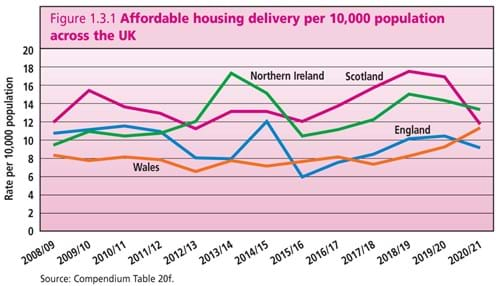01 Apr 2022
How do we drive up the supply of social rented homes?
In England we’re building fewer than 7,000 new social rented homes each year. Yet studies show a colossal shortfall against the numbers really required – estimated at 90,000 per year before the pandemic and now likely to be higher still. Although we have a new Affordable Homes Programme (AHP), it is likely to raise output to 11,000 or so at best. So what more can be done to address housing need?

The UK Housing Review 2022 looks in detail at the issue of affordable housing supply. It points out that, when output is compared between UK countries on the basis of new homes per 10,000 population, England performs worst (see chart). Looking specifically at building social rented homes, Scotland is building enough that, since 2016, it’s gained 25,000 social rented homes. By contrast, since 2012, England has lost 208,000 social rented homes. This is because it has not only failed to build in sufficient numbers, it has also reduced its stock by converting it to Affordable Rents or by selling it under the right to buy. Neither of these apply in Scotland: right to buy stopped in 2016 and Affordable Rent lettings have never been used.
Another significant factor is grant rates. In Scotland, they are now typically over £70,000, while in England under the AHP that ended last year, grants for social rent outside London ran at an average of £57,000 per new home. Under the current programme grants will be higher, but for social rent they will only be available in areas of high house prices, meaning much of the North and Midlands will miss out.
The NHF has said that, to build 90,000 social rented homes annually, grants would have to rise to £183,000 per unit, and the programme would then cost £14 billion annually rather than the current £2 billion. However, even if this means the gap can’t realistically be closed soon, it could at least be substantially narrowed. One step would be to halt the loss of social rented homes – one that could be taken quickly if the government were minded to do it.
Expanding supply would require more money, and there are two good arguments for providing it. One was put forward by CIH last year in a report it produced with the Centre for Homelessness Impact. This showed that building new homes for social rent would save money if the new homes were used for a combination of replacing private temporary accommodation and rehousing private tenants paying high rents and receiving benefits.
The UK Housing Review makes another key suggestion about use of government resources. Unlike Scotland, Wales and Northern Ireland, more than half of government support for housing investment in England goes to the private market, through funding stream like Help to Buy, the Land and Infrastructure Fund, and so on. But Help to Buy will soon come to an end, and the private sector is increasingly taking on the task of making the market accessible to first-time buyers. Why then, not shift a substantial proportion of this money across to support affordable housing instead? The sums are substantial: over the next four years, over £40 billion will be spent on propping up the private market. Redirecting a significant proportion of this money to support affordable housing – and especially social rent – wouldn’t close the gap and deliver 90,000 homes annually. But it would bring us a lot closer to achieving it.
If you're a CIH member, the UK Housing Review 2022 is now available to download for free as part of your membership.
Not a member? You can purchase your copy of the UK Housing Review 2022 from the CIH Bookshop. An executive summary is also available for download on our publications listing.
John Perry is a policy advisor at the Chartered Institute of Housing. He edits the UK Housing Review and also advises on a wide range of subjects including planning, local authority finance, plus much more. John is a chartered CIH member.


